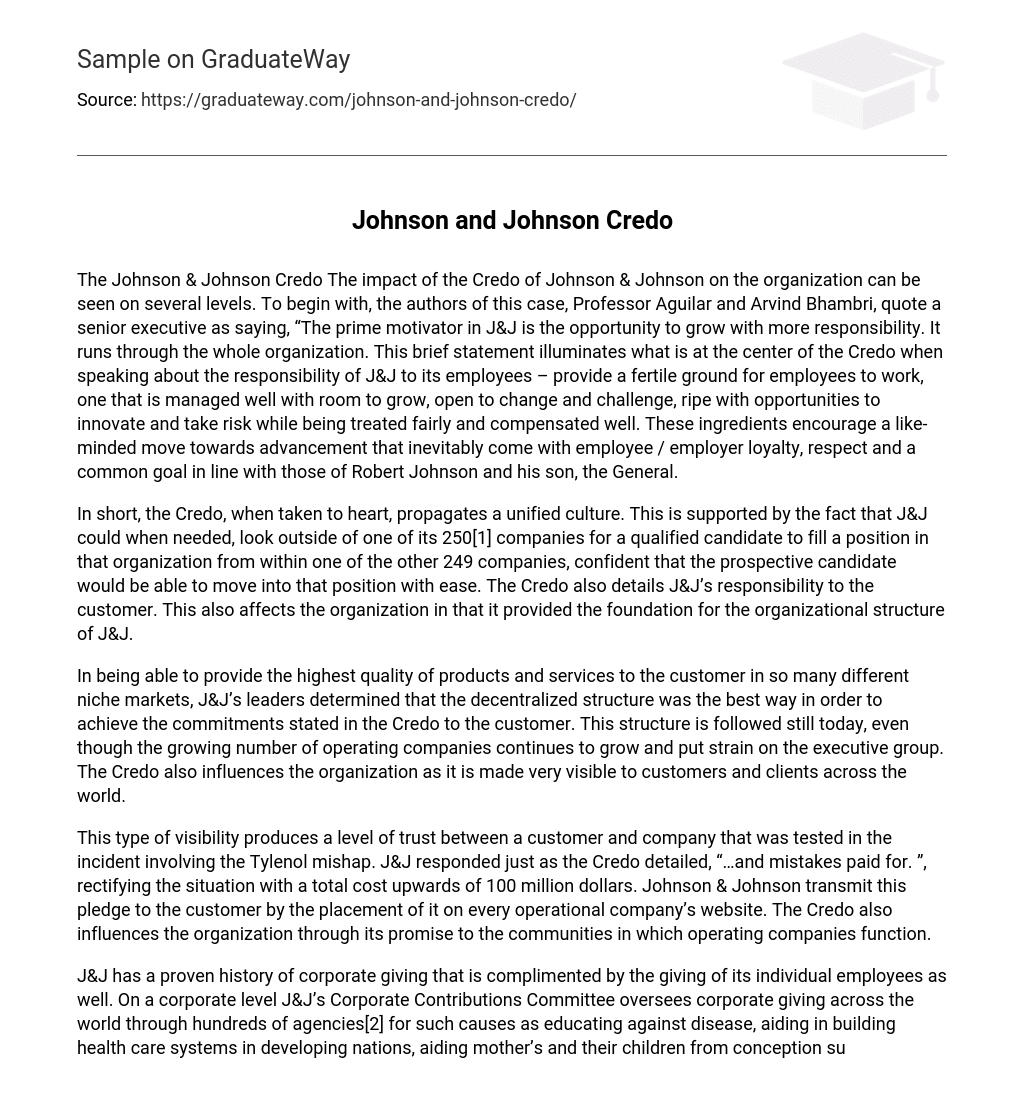The Johnson & Johnson Credo has a significant impact on the organization at multiple levels. According to Professor Aguilar and Arvind Bhambri, a senior executive at J&J emphasizes that the opportunity for growth and increased responsibility is a major driving force within the company. This remark highlights the importance of J&J’s responsibility towards its employees – creating a conducive environment for work, effective management, ample opportunities for growth and innovation, willingness to embrace change and challenges, fair treatment, and satisfactory compensation. These factors foster loyalty and respect between employees and employers, ultimately aligning with the vision of Robert Johnson and his son, the General.
Essentially, the Credo promotes a unified culture within J&J. This is evident in the ability of J&J to consider candidates from any of its 250 companies to fill positions within another company, knowing that they will seamlessly transition into their new role. The Credo also outlines J&J’s commitment to their customers, which plays a significant role in shaping the organization’s structure.
J&J’s leaders decided that the decentralized structure was the most effective way to deliver high-quality products and services to customers in various niche markets, aligning with the commitments outlined in the Credo. This structure remains intact today, despite the increasing number of operating companies, which adds pressure to the executive group. Customers and clients worldwide are also aware of the Credo, as it is prominently displayed within the organization.
This type of visibility creates a level of trust between a customer and a company that was put to the test during the incident involving the Tylenol mishap. J&J responded in line with the details outlined in the Credo, which stated, “…and mistakes paid for.”, by rectifying the situation at a great cost of over 100 million dollars. Johnson & Johnson demonstrates this commitment to customers by displaying it on every operational company’s website. The Credo also shapes the organization’s actions by making promises to the communities in which they operate.
J&J has a proven history of corporate giving that is complemented by the giving of its individual employees as well. On a corporate level, J&J’s Corporate Contributions Committee oversees corporate giving worldwide through hundreds of agencies[2]. The company supports causes such as educating against disease, aiding in building healthcare systems in developing nations, and helping mothers and children survive birth. Johnson & Johnson has always been committed to women and children, both in their product offerings and their support and care through giving.
J&J has consistently shown their commitment to the community by providing disaster relief throughout their history. In 2006, they set forth goals for the year 2010 known as “Healthy Planet 2010”. As part of their dedication to transparency, J&J aims to openly disclose the environmental impact each facility has on both the community and the environment. Currently, 60% of their operating companies have already submitted this information. While responsibility to stockholders is the final aspect of the Credo, it is no less significant than the other parts and equally affects the organization.
Impact on the organization is felt through J&J’s business practices, such as financial planning and strategic planning that is directly linked back to the Credo. The 10-year financial plan is reviewed every 5 years. The principles guiding J&J’s strategic planning include: the success of the corporation is due to presidents and managing directors, businesses should be organized around consumer needs, seek market leadership opportunities while maintaining high quality, commit to high growth rates, finance growth from earnings, and use expansion criteria of compatibility, growth potential, economic practicability, and sound management capacity. The Credo created by Robert Johnson has shaped the culture of all Johnson & Johnson companies and is an encouraging business statement.
Reading this document is captivating. It is not surprising that Credo is able to unite this decentralized organization. It appeals to one’s passion and desire to be part of a proactive, productive, and successful organization. A company that strives for the common good of its employees, stockholders, suppliers, customers, and stakeholders. This enthusiasm can extend beyond company and national borders.
One last intangible ingredient that remains in the Credo is the imprint left by the founder, Robert Johnson. Remarkably, even after a century, J&J remains committed to the long-term success of the community, shareholders, and employees, just as Johnson and later the General had originally envisioned for the company. Works Cited 1. “Johnson & Johnson Corporate Contributions & Community Relations”. 2009. http://www. jnj. com/wps/wcm/connect/ c13fb7804ae70e59bbb4fb0f0a50cff8/our-key-partners. df? MOD=AJPERES 2. “Our Management Approach – Our Credo Values”. 2009. http://www. jnj. com/connect/about-jnj/management-approach/. —– [1] When Professor Aguilar and Arvind Bhambri wrote this report, there were 150 operating companies. Currently, this number has increased to just over 250; from “Our Management Approach – Our Credo Values”. [2] From Johnson & Johnson Corporate Contributions & Community Relations





